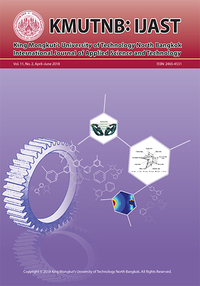An Enhancement of Lighting System Energy Efficiency Using an Automatic Light Dimming Control
Main Article Content
Abstract
Concerning about country’s energy situation which depends on the import mainly and Global Warming the world’s problem is also concern as well. So, this paper mentions a way to decrease the effect of those problems enhancing the energy efficiency in lighting system with an innovation using simple technology. After doing the energy conservation potential analysis of the original system, an automatic light dimming control using PI controller is the one in set of innovations will be developed. This control was designed using operational amplifier circuit and set PI gain using Ziegler-Nichols open-loop technique. This control has been installed and is being used in a classroom. With this control, the energy can be saved 6.36 kWh per month and the energy efficiency has been enhanced with the energy efficiency indicator 2.45 W/100 lx/m2 decreased from 2.61 the former level.
Article Details
References
[2] European Commission’s Joint Research Centre and Netherlands Environmental Assessment Agency. (2012). CO2 Emissions per capita. Thai energy solution. EU [Online]. Available: http:// www.thaienergy solution.com
[3] Carbon Dioxide Information Analysis Center, Tennessee, United States. (2015). CO2 emissions (metric tons per capita). World Bank. United States [Online]. Available: http://data.worldbank. org/indicator
[4] Office of the Prime Minister. (2011). The Eleventh National Economic and Social Development Plan (2012–2016). Nesdb. Thailand [Online]. Available: http://www.nesdb.go.th:80/Portals/0/news/plan/ p11/Plan11_eng.pdf (in Thai)
[5] European Commission. (2012). EU GPP Criteria for Indoor Lighting. EC. EU [Online]. Available: http://ec.europa.eu/environment/gpp/eu_gpp_ criteria_ en.htm
[6] L. Matirano, “Lighting systems to save energy in educational classrooms,” in Proceedings International Conference on Environment and Electrical Engineering, IEEE, Rome, 2011, pp. 1–5.
[7] Department of Alternative Energy Development and Efficiency, “Best practices for energy conservation in designated building and designated factory,” Ministry of Energy, Bangkok, Thailand, 2014 (in Thai).
[8] European Committee for Standardization. (2002). Light and Lighting - Lighting of Work Places - Part 1: Indoor Work Places. UAB AGETA Corp. EU [Online]. Available: http://www.ageta.lt/app/ webroot/files/uploads/filemanager/File/info/ EN_12464-1.pdf
[9] J. G. Ziegler and N. B. Nichols, “Optimum settings for automatic controllers,” Transactions of ASME, vol. 64, no. 8, pp. 759–768, 1942.
[10] N. Ramesh Raju and P. Linga Reddy, “Optimum self tuning of PID controller parameters for level control system against parameter variations by neural network trained with GA optimized data,” International Journal of Engineering and Technology (IJET), vol. 7, No 5, pp. 1716–1725, 2015.
[11] The Nation. (2010). Thailand: Preparation for Nuclear Power Plant Stepped Up. Thai Visa. Thailand [Online]. Available: http://www. thaivisa.com/forum/topic/356047-thailandpreparation- for-nuclear-power-plant-stepped-up/ (in Thai).
[12] D. A. Anibal, S. Bruno, P. Bertoldi, and Q. Michel, “Solid state lighting review- Potential and challenges in Europe,” Renewable and Sustainable Energy Reviews, vol. 34, pp. 30–48, 2014.
[13] Mines-paristech. (2013). Energy units and conversion factors. Mines-paristech. Paris [Online]. Available: http:// direns.mines-paristech. fr/Sites/Thopt/en/co/equivalences-energetiques. html
[14] Traditionaloven. (2016). Energy units conversion. Traditionaloven. United Kingdom [Online]. Available: http://www.traditionaloven.com/ tutorials/energy/convert-ton-oil-equivalent-toeto- barrel-oil-equivalent-boe.html
[15] A. Georgia, R. Angle, and V. Martin, “Comparison of the indoor performance of 12 commercial PV products by a simple model,” Research Article of Energy Science and Engineering, vol. 4, no. 1, pp. 69–85, 2016.


